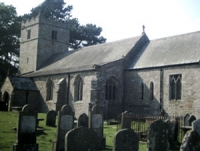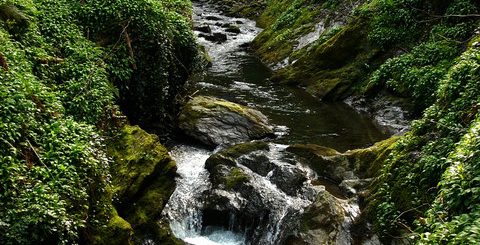Each Uisge
The Each Uisge, is a name for the Highland supernatural water horse, supposedly the most dangerous of the Scottish water dwelling creatures. The monster inhabited the sea, sea lochs and fresh water lochs and is sometimes mistaken in writing as the Kelpie, which is supposed to inhabit rivers and streams.
The Each Uisge had the ability to shape shift, and could disguise itself as a fine horse or pony. To lure people into the water it would stand by the waters edge in one of these forms, and wait for somebody to approach. If a man was to mount the horse, it would immediately set off into the deepest part of the loch, the rider being unable to free himself because of the adhesive qualities of the creature’s skin. Once in its element, the unfortunate victim would drown, and be devoured completely apart from the liver, which would float ashore, a sure sign that the water horse had claimed another victim.
 Another disguise the Each Uisge could take was that of a handsome man, and because of the danger of these creatures, people were wary of lone animals and strangers standing by the waters edge, in places reputed to be haunted by the Each Uisge.
Another disguise the Each Uisge could take was that of a handsome man, and because of the danger of these creatures, people were wary of lone animals and strangers standing by the waters edge, in places reputed to be haunted by the Each Uisge.
As well as human victims the Each Uisge also ate cattle and sheep, and could be lured from the water and killed with the smell of roasted meat. One such tale is recorded in ‘More West Highland Tales’ by McKay: A blacksmith from Raasay lost his daughter to the Each Uisge. In revenge the blacksmith and his son made a set of large hooks, in a forge they set up by the loch side. They then roasted a sheep and heated the hooks until they were red hot. At last a great mist appeared from the water and the Each Uisge rose from the depths and seized the sheep. The blacksmith and his son rammed the red-hot hooks into its flesh and after a short struggle dispatched it. In the morning there was nothing left of the creature apart from a jelly like substance.
It has been theorised that the folklore of the water horse stems in part from real encounters with water dwelling creatures in the deep lochs. These are paralleled today with sightings in places such as Loch Ness and Loch Morar. Of course it could be the other way round and what people are seeing is archetypal images somehow portrayed onto the water. In truth nobody knows and the similarity with folklore and modern sightings may be pure coincidence.




Re: Each Uisge
According to Folklore of Scottish Lochs and Springs by James Mackinlay (1893) ‘Lonely lochs were their favourite haunts. In treeless regions, a belief in such creatures would naturally arise. Any ordinary animal in such an environment would appear of a larger size than usual, and the eye of the beholder would transmit the error to his imagination, thereby still further magnifying the creature’s bulk. In some instances, the notion might arise even when there was no animal on the scene. A piece of rock, or some other physical feature of the landscape would be enough to excite superstitious fancies. Mr. Campbell remarks, "In Sutherland and elsewhere, many believe that they have seen these fancied animals. I have been told of English sportsmen who went in pursuit of them, so circumstantial were the accounts of those who believed they had seen them. The witnesses are so numerous, and their testimony agrees so well, that there must be some old deeply-rooted Celtic belief which clothes every object with the dreaded form of the Each Uisge, i.e., Water-horse." When waves appeared on a lake, and there seemed no wind to account for them, superstitious people readily grasped at the idea that the phenomenon was due to the action of some mysterious water-spirit. As Dr. Tylor points out, there seems to have been a confusion "between the `spiritual water-demon’ and the `material water-monster." Any creature found in or near the water would naturally be reckoned its guardian spirit.